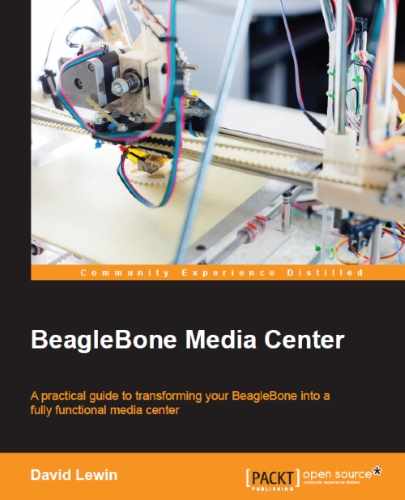Book Description
A practical guide to transforming your BeagleBone into a fully functional media center
In Detail
Every new embedded board that comes into existence gives us the power to access highly technological objects that can be shaped according to our desires and ideas. BeagleBone is one such low power, open source, single-board computer with all the functionality of a basic computer.
This book begins with a quick installation of MediaDrop, a versatile media content manager, showing you how to manage your music, video, and podcasts. You will learn how to configure access permissions for your users and select the way you would want them to retrieve your shared media. Next, you'll get to grips with how to use existing ready-to-use modules or video devices in your own projects. As you continue your journey, you will learn how to build your personal media player. Toward the end of the book, you will create an interesting project using BeagleBone, that is, an 8 x 8 LED matrix that will groove to your music.
By the end of the book, you will be armed with all the knowledge required to interface and configure all media center components using BeagleBone.
What You Will Learn
- Retrieve all your media from your home or anywhere in the world
- Configure access control permissions for your users
- Create your own tablet using a display device to watch and listen to media, play games, and more
- Share your media with friends through social networking sites such as Facebook and Twitter without compromising security
- Set up your server in no time and access it through your computer or any connected devices
- Create your personal hosting services in your home or office
- Set up a proof-of-concept quickly to impress your boss with your ideas
- Integrate Adafruit's bicolor LED pixel matrix with your BeagleBone board to make the LEDs dance to your music
Downloading the example code for this book. You can download the example code files for all Packt books you have purchased from your account at http://www.PacktPub.com. If you purchased this book elsewhere, you can visit http://www.PacktPub.com/support and register to have the files e-mailed directly to you.
Table of Contents
- BeagleBone Media Center
- Table of Contents
- BeagleBone Media Center
- Credits
- About the Author
- About the Reviewers
- www.PacktPub.com
- Preface
- 1. Transforming Your BeagleBone Black into a Media Server
- The choice that is not yours
- Your server, your rules
- Looking at daily scenarios for media usage
- Down in the cave is a server without a head – headless servers
- Preparing BeagleBone to be a server
- Let's get acquainted with our friend – MediaDrop
- MediaDrop installation steps
- BBB Debian – prerequisites
- Setting up a dedicated database
- Step 1 – set up a Python virtual environment
- Step 2 – installing MediaDrop
- Step 3 – basic configuration file
- Step 4 – copying content from the initial data
- Step 5 – filling the server database and contents
- Step 6 (optional) – full-text searching
- Testing time – "Hello Server"
- Switching from development to production
- Let's take a walk in our new MediaDrop server
- Self-test questions
- Summary
- 2. Media Management, Shares, and Social Activities
- 3. Examples of Real-world Situations
- 4. Getting Your Own Video and Feeds
- Detecting the hardware device and installing drivers and libraries for a webcam
- Installing and running MJPG-Streamer
- Configuring RSS feeds with Leed
- Summary
- 5. Building Your Media Player
- Introducing BeagleBone capes
- Considering a personal Palm Media player
- Installing a system for the expansion board
- Using the expansion board with Android
- Summary
- 6. Illuminate Your Imagination with Your Own Projects
- Presenting the "matrix revolution"
- Diving into the software
- Example 1 – our first client server application
- Example 2 – improving the first example by adding functionalities
- Example 3 – creating animated graphical patterns
- Following the project's requirements
- Where to find help on the Internet
- Looking at the differences from the previous example
- Looking at the concepts of the matrix edition
- Browsing the code
- Compilation time
- Describing the GUI
- A quick tour of the code
- Looking at the main functions
- Questions and thoughts related to this example
- Summary
- A. Troubleshooting and Tricks to Improve Your Server
- B. Ideas to Improve Your Server
- Index
